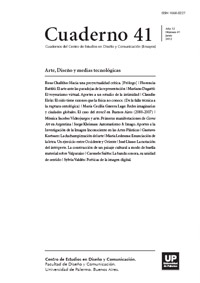La notación del intérprete. La construcción de un paisaje cultural a modo de huella material sobre Valparaíso
Abstract
The concept of landscape is a cultural construction, in wich the experience takes shape as a material sprint. The subject and it’s interpretation from the experience, elaborates a type of notation that ultimately constructs a time and space as a social product. This strategy proposes the construction of a place beyond the praxis or a kind of rhetorical lecture. The space and it’s material representation as the composition of a place, puts the identity concept as a cultural reference that link the sign, the tectonic space and its ways of retention as a local cultural ground. To acknowledge belonging as identity and interpretation as appropriation, a type of heterotopic and open action field is formed, because it englobes the differences as a process of habitability in relation to the context and language, inter-mixing spacial practices and tectonicities as entropic marks. This way, the notation of the interpreter and it’s tangible
sprint opens a world of languages.
References
Allen, S. (2000). Practice: Architecture, technique and representation. London: Routledge
Augé, M. (1993). Los no lugares. Espacios del anonimato. Barcelona: Gedisa.
Bajtín, M. (1989). Las formas del tiempo y del cronotopo en la novela. Ensayos sobre Poética Histórica. En Teoría y estética de la novela. Madrid: Taurus.
Calderón, A. (2001). El memorial de Valparaíso. Santiago de Chile: Ed. Rhil.
Cuesta, J. M. (2001). La escritura del instante. Una poética de la temporalidad. Madrid: Ed. Akal.
Enaudeau, C. (1998). La paradoja de la representación. Buenos Aires: Ed. Paidos.
Flores, S. (2005). El acontecer infausto en un Valparaíso sorprendente. Valparaíso: Ed. Fac. humanidades UPLA y Universidad de Valparaíso.
Fried S. D. (1995). Nuevos Paradigmas, Cultura y Subjetividad. Buenos Aires: Ed. Paidós.
Gadamer, H. (1994). Verdad y método. Salamanca: Sígueme.
Gavira, C. (2000). Ecología del ambiente artificial. En Revista Astrágalo. Cultura de la arquitectura y la ciudad. Nº16, Madrid. Diciembre 2000.
Giddens, A. (1990). Consecuencias de la modernidad. Madrid: Ed. Alianza.
Gruner, E. (2002). El fin de las pequeñas historias. De los estudios culturales al retorno (imposible) de lo trágico. Buenos Aires: Ed. Paidós.
Hajer, M. y Reijndorp, A. (2000). In Search of new public domain. Rotterdam: Nai Publishers.
Halpert, M. (2004). El espacio oculto. En: Otros modos de habitar. Reflexiones. Santiago de Chile: Ed. Universidad Central.
Jameson, F. (1996). La lógica cultural del capitalismo tardío. En Teoría de la posmodernidad. Madrid: Trotta.
Lefevbre, H. (1970). La revolución urbana. Madrid: Alianza Editorial.
Lyotard, J.-F. (1989). La condición posmoderna. Madrid: Cátedra.
Quiñónez, G. (1957). Valparaíso… cerros, barrancos, abismo y pueblos. Revista En Viaje. Santiago de Chile.
Roger, A. Breve tratado del paisaje.
Soja, E. (2000). Thirdspace. Journeys to los Angeles and other real-and-imagined places. California: Blackwell Publishing.
Sola-Morales, I. (2003). Territorios. Editorial Barcelona: Gustavo Gili.
Valéry, P. (1970). Eupalinos ou l’architècte. Paris: Editions Flammarion.
Los autores/as que publiquen en esta revista ceden los derechos de autor y de publicación a "Cuadernos del Centro de Estudios de Diseño y Comunicación", Aceptando el registro de su trabajo bajo una licencia de atribución de Creative Commons, que permite a terceros utilizar lo publicado siempre que de el crédito pertinente a los autores y a esta revista.


